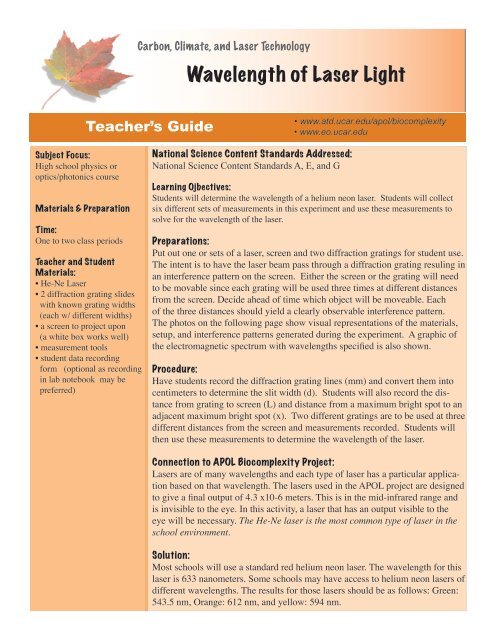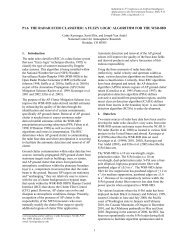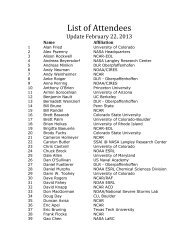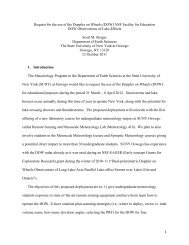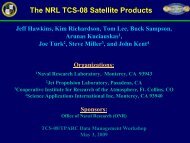Wavelength of a Laser - eol
Wavelength of a Laser - eol
Wavelength of a Laser - eol
Create successful ePaper yourself
Turn your PDF publications into a flip-book with our unique Google optimized e-Paper software.
Subject Focus:<br />
High school physics or<br />
optics/photonics course<br />
Materials & Preparation<br />
Time:<br />
One to two class periods<br />
Carbon, Climate, and <strong>Laser</strong> Technology<br />
Teacher’s Guide<br />
Teacher and Student<br />
Materials:<br />
• He-Ne <strong>Laser</strong><br />
• 2 diffraction grating slides<br />
with known grating widths<br />
(each w/ different widths)<br />
• a screen to project upon<br />
(a white box works well)<br />
• measurement tools<br />
• student data recording<br />
form (optional as recording<br />
in lab notebook may be<br />
preferred)<br />
<strong>Wavelength</strong> <strong>of</strong> <strong>Laser</strong> Light<br />
National Science Content Standards Addressed:<br />
National Science Content Standards A, E, and G<br />
• www.atd.ucar.edu/apol/biocomplexity<br />
• www.eo.ucar.edu<br />
Learning Ojbectives:<br />
Students will determine the wavelength <strong>of</strong> a helium neon laser. Students will collect<br />
six different sets <strong>of</strong> measurements in this experiment and use these measurements to<br />
solve for the wavelength <strong>of</strong> the laser.<br />
Preparations:<br />
Put out one or sets <strong>of</strong> a laser, screen and two diffraction gratings for student use.<br />
The intent is to have the laser beam pass through a diffraction grating resuling in<br />
an interference pattern on the screen. Either the screen or the grating will need<br />
to be movable since each grating will be used three times at different distances<br />
from the screen. Decide ahead <strong>of</strong> time which object will be moveable. Each<br />
<strong>of</strong> the three distances should yield a clearly observable interference pattern.<br />
The photos on the following page show visual representations <strong>of</strong> the materials,<br />
setup, and interference patterns generated during the experiment. A graphic <strong>of</strong><br />
the electromagnetic spectrum with wavelengths specified is also shown.<br />
Procedure:<br />
Have students record the diffraction grating lines (mm) and convert them into<br />
centimeters to determine the slit width (d). Students will also record the distance<br />
from grating to screen (L) and distance from a maximum bright spot to an<br />
adjacent maximum bright spot (x). Two different gratings are to be used at three<br />
different distances from the screen and measurements recorded. Students will<br />
then use these measurements to determine the wavelength <strong>of</strong> the laser.<br />
Connection to APOL Biocomplexity Project:<br />
<strong>Laser</strong>s are <strong>of</strong> many wavelengths and each type <strong>of</strong> laser has a particular application<br />
based on that wavelength. The lasers used in the APOL project are designed<br />
to give a final output <strong>of</strong> 4.3 x10-6 meters. This is in the mid-infrared range and<br />
is invisible to the eye. In this activity, a laser that has an output visible to the<br />
eye will be necessary. The He-Ne laser is the most common type <strong>of</strong> laser in the<br />
school environment.<br />
Solution:<br />
Most schools will use a standard red helium neon laser. The wavelength for this<br />
laser is 633 nanometers. Some schools may have access to helium neon lasers <strong>of</strong><br />
different wavelengths. The results for those lasers should be as follows: Green:<br />
543.5 nm, Orange: 612 nm, and yellow: 594 nm.
grating<br />
Grating in position in from <strong>of</strong> laser<br />
<strong>Laser</strong>, grating, and screen<br />
<strong>Laser</strong>, grat ing, an d screen<br />
Gra ting in po sition in from <strong>of</strong> laser<br />
<strong>Laser</strong>, 300 lines/mm grating, and screen<br />
Electromagnetic Spectrum<br />
<strong>Laser</strong> and two gratings<br />
<strong>Laser</strong>, 300 lines/mm grating, and screen<br />
Pattern generated by laser and 300 lines/mm grating<br />
Photos by Randal Albrandt<br />
2 <strong>of</strong> 2
Diffraction Grating<br />
(lines/mm)<br />
Slit Width (d)<br />
(cm/line)<br />
Two different gratings must be used three times each.<br />
Distance from<br />
grating to screen (L)<br />
(cm)<br />
Distance from<br />
maximum to<br />
maximum (x)<br />
Note that x can be measured from any bright spot to the adjacent bright spot. Also, the diffraction gratings are<br />
in lines per mm. This must be converted to cm per line. This value corresponds to d in Diagram A.<br />
To determine the wavelength <strong>of</strong> the laser:<br />
( x )( d)<br />
λ =<br />
Use the values <strong>of</strong> x, d, and L from your data table and the double slit formula L to determine<br />
the wavelength <strong>of</strong> the laser. Average your six computed values and determine a final average for the wavelength<br />
<strong>of</strong> the laser.<br />
Show all<br />
substitutions<br />
<strong>of</strong><br />
data into<br />
formula<br />
Final Value<br />
(cm)<br />
Final value<br />
(microns)<br />
( x )( d)<br />
λ =<br />
L<br />
( x )( d)<br />
λ =<br />
L<br />
<strong>Wavelength</strong> <strong>of</strong> <strong>Laser</strong> Light<br />
Student Data Form<br />
( x )( d)<br />
λ =<br />
L<br />
( x )( d)<br />
λ =<br />
L<br />
( x )( d)<br />
λ =<br />
L<br />
( x )( d)<br />
λ =<br />
L<br />
Average<br />
<strong>Wavelength</strong><br />
Ask your teacher to provide you with the actual wavelength <strong>of</strong> the laser used in your experiment. Compare this<br />
value with your experimental value. Discuss any aspects <strong>of</strong> the experiment that would explain any disagreement<br />
with the actual value.<br />
1 <strong>of</strong> 2
Diagram A<br />
2 <strong>of</strong> 2


